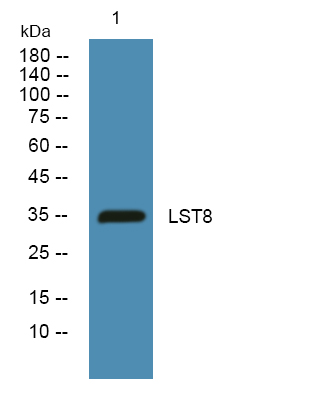LST8 Polyclonal Antibody
- Catalog No.:YN2394
- Applications:WB;ELISA
- Reactivity:Human;Rat;Mouse
- Target:
- LST8
- Fields:
- >>Autophagy - other;>>Autophagy - animal;>>mTOR signaling pathway;>>PI3K-Akt signaling pathway;>>Thermogenesis
- Gene Name:
- MLST8 GBL LST8
- Protein Name:
- Target of rapamycin complex subunit LST8 (TORC subunit LST8) (G protein beta subunit-like) (Gable) (Protein GbetaL) (Mammalian lethal with SEC13 protein 8) (mLST8)
- Human Gene Id:
- 64223
- Human Swiss Prot No:
- Q9BVC4
- Mouse Swiss Prot No:
- Q9DCJ1
- Rat Swiss Prot No:
- Q9Z2K5
- Immunogen:
- Synthesized peptide derived from human protein . at AA range: 100-180
- Specificity:
- LST8 Polyclonal Antibody detects endogenous levels of protein.
- Formulation:
- Liquid in PBS containing 50% glycerol, and 0.02% sodium azide.
- Source:
- Polyclonal, Rabbit,IgG
- Dilution:
- WB 1:500-2000 ELISA 1:5000-20000
- Purification:
- The antibody was affinity-purified from rabbit antiserum by affinity-chromatography using epitope-specific immunogen.
- Concentration:
- 1 mg/ml
- Storage Stability:
- -15°C to -25°C/1 year(Do not lower than -25°C)
- Observed Band(KD):
- 35kD
- Background:
- function:Unessential component of the TORC1 complex and essential component of the TORC2 complex. TORC1 controls cell growth in response to environmental signals, and is inactivated by nutrient limitation and environmental stress. Within TORC1, LST8 interacts directly with FRAP1 and enhances its kinase activity. In nutrient-poor conditions, stabilizes the FRAP1-RAPTOR interaction and favors RAPTOR-mediated inhibition of FRAP1 activity. TORC2 controls polarity of the actin cytoskeleton via the RAC1 pathway. TORC2 mediates phosphorylation of Akt/PKB on 'Ser-473' and phosphorylation of PKCalpha on 'Ser-657'.,similarity:Belongs to the WD repeat LST8 family.,similarity:Contains 7 WD repeats.,subunit:Interacts with FRAP1, RAPTOR and RHEB. Part of the target of rapamycin complex 1 (TORC1) which contains LST8, FRAP1, RAPTOR and AKT1S1. TORC1 binds to and is inhibited by FKBP12-rapamycin. Part of the target of rapamycin complex 2 (TORC2) which contains FRAP1, LST8, PROTOR1, RICTOR and MAPKAP1. Contrary to TORC1, TORC2 does not bind to and is not sensitive to FKBP12-rapamycin.,tissue specificity:Broadly expressed, with highest levels in skeletal muscle, heart and kidney.,
- Function:
- function:Unessential component of the TORC1 complex and essential component of the TORC2 complex. TORC1 controls cell growth in response to environmental signals, and is inactivated by nutrient limitation and environmental stress. Within TORC1, LST8 interacts directly with FRAP1 and enhances its kinase activity. In nutrient-poor conditions, stabilizes the FRAP1-RAPTOR interaction and favors RAPTOR-mediated inhibition of FRAP1 activity. TORC2 controls polarity of the actin cytoskeleton via the RAC1 pathway. TORC2 mediates phosphorylation of Akt/PKB on 'Ser-473' and phosphorylation of PKCalpha on 'Ser-657'.,similarity:Belongs to the WD repeat LST8 family.,similarity:Contains 7 WD repeats.,subunit:Interacts with FRAP1, RAPTOR and RHEB. Part of the target of rapamycin complex 1 (TORC1) which contains LST8, FRAP1, RAPTOR and AKT1S1. TORC1 binds to and is inhibited by FKBP12-rapamycin. Part of
- Subcellular Location:
- Cytoplasm .
- Expression:
- Broadly expressed, with highest levels in skeletal muscle, heart and kidney.
- June 19-2018
- WESTERN IMMUNOBLOTTING PROTOCOL
- June 19-2018
- IMMUNOHISTOCHEMISTRY-PARAFFIN PROTOCOL
- June 19-2018
- IMMUNOFLUORESCENCE PROTOCOL
- September 08-2020
- FLOW-CYTOMEYRT-PROTOCOL
- May 20-2022
- Cell-Based ELISA│解您多样本WB检测之困扰
- July 13-2018
- CELL-BASED-ELISA-PROTOCOL-FOR-ACETYL-PROTEIN
- July 13-2018
- CELL-BASED-ELISA-PROTOCOL-FOR-PHOSPHO-PROTEIN
- July 13-2018
- Antibody-FAQs
- Products Images

- Western blot analysis of lysates from SW480 cells, primary antibody was diluted at 1:1000, 4°over night



